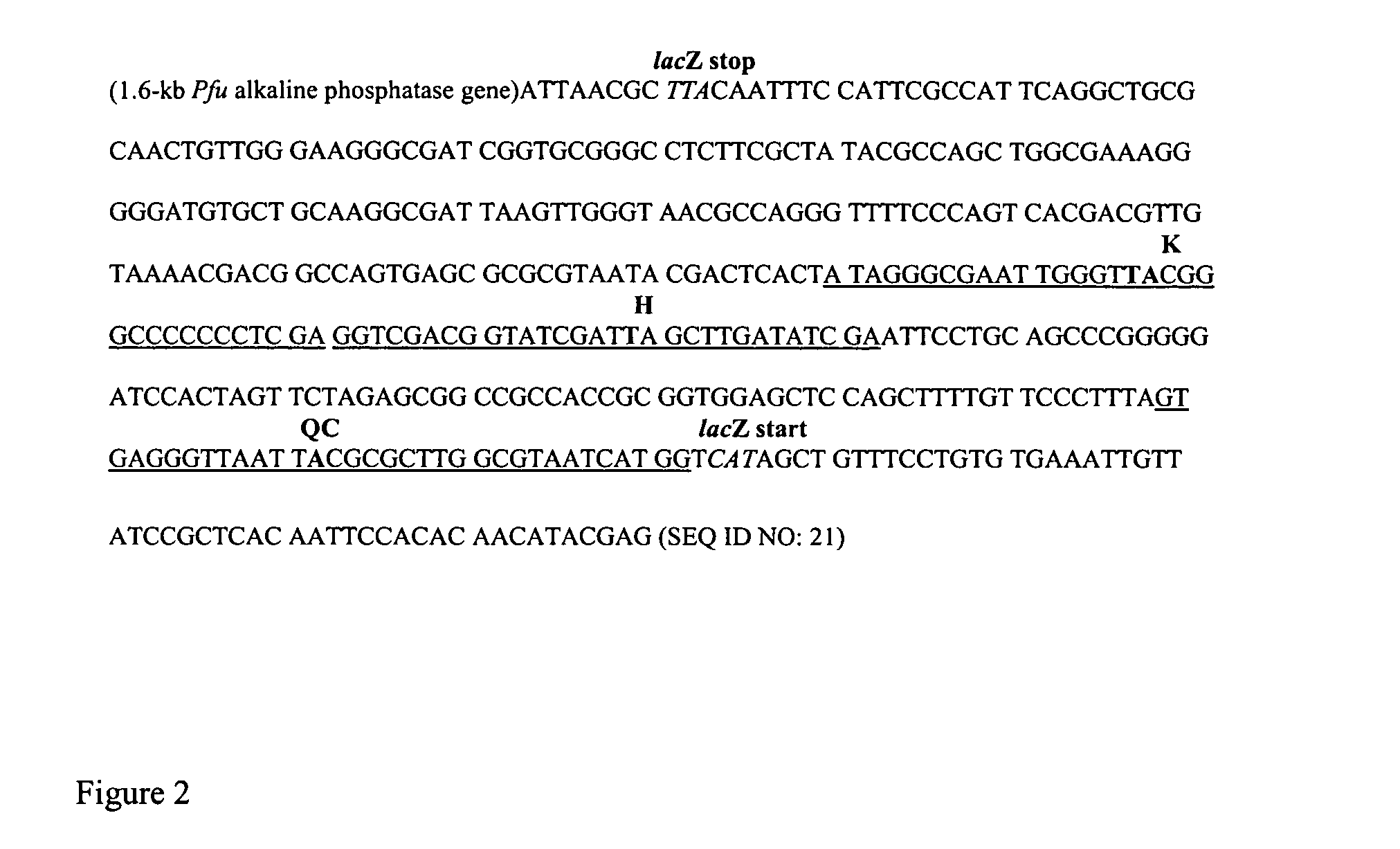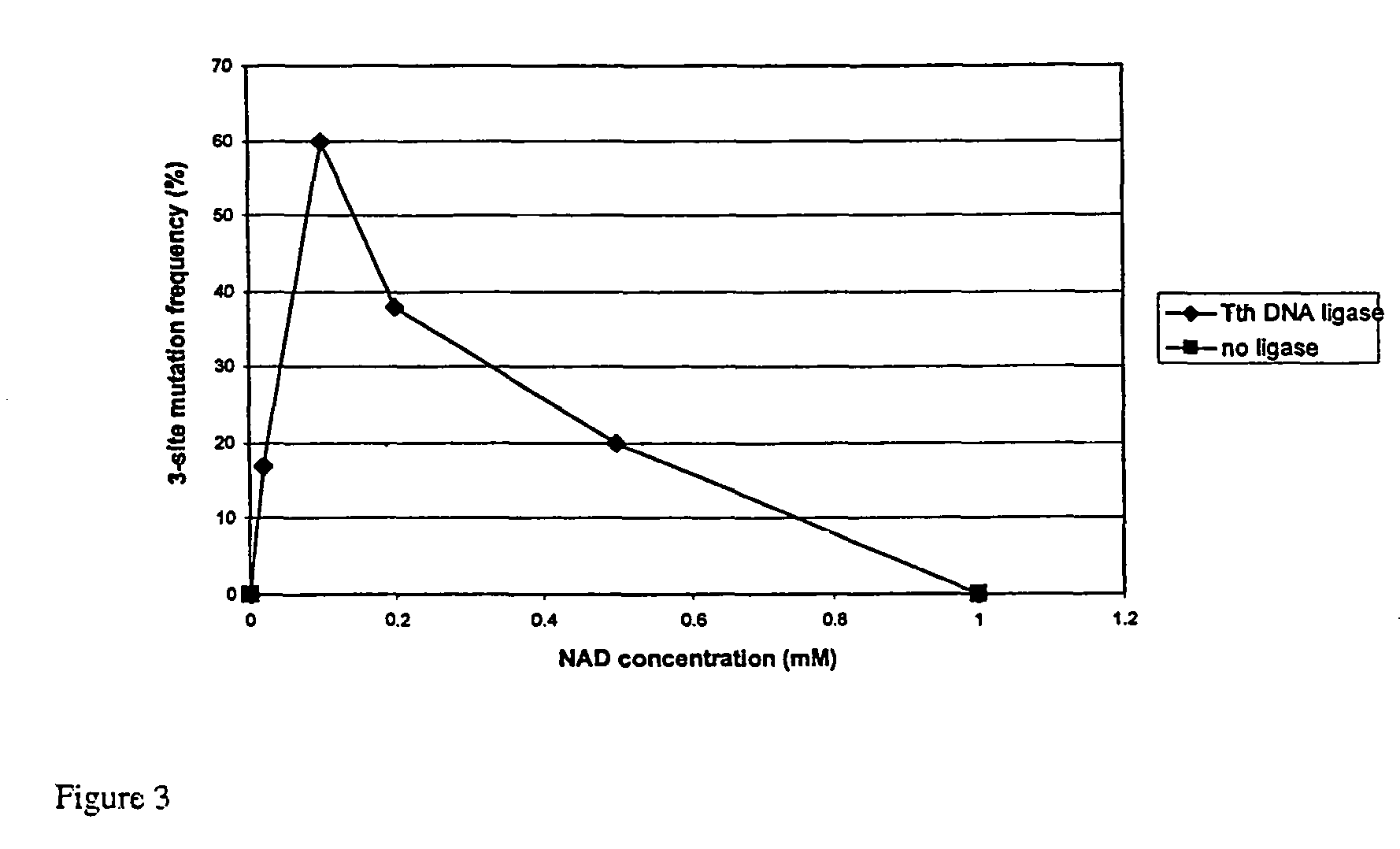Multi-site mutagenesis
a mutagenesis and multi-site technology, applied in the field of polynucleotide sitedirected mutagenesis, can solve the problems of reducing the time between consecutive rounds of mutagenesis, requiring time-consuming transformation and screening steps, and limited conventional pcr-based site-directed mutagenesis methods, etc., and achieve the effect of optimizing the cycling conditions
- Summary
- Abstract
- Description
- Claims
- Application Information
AI Technical Summary
Benefits of technology
Problems solved by technology
Method used
Image
Examples
example 1
Materials and Methods
Enzymes and Reagents
[0221]The materials used in the following examples are obtained from Stratagene and other bioreagent providers as listed below.
PfuTurbo DNA polymerase (Stratagene, Cat. #600252)
Taq DNA ligase (New England BioLabs #M0208S)
Pfu FEN-1
dNTPs (Stratagene, Cat. #200415)
Dpn I (Stratagene, Cat. #500402)
QuikSolution (Stratagene, Cat. 200516)
control plasmid DNA (pWS72I)
control primer mix (QC1, K2, H2)
βME
XL 10-Gold® ultracompetent cells (Stratagene, Cat. 200314), Pfu DNA ligase (Stratagene, Cat. #600191), Tth DNA ligase (Stratagene, discontinued product; lot #123402A used here),
BSA (Stratagene, Cat. #300041).
[0222]Components for reaction buffer (e.g., Tris-HCl, KCl, (NH4)2SO4, MgCl2, and MgSO4) were obtained form various reagent providers. NAD (Sigma #N1636) was prepared as a 10 mM stock solution in water and stored at −20° C. 10× reaction buffers were prepared and stored at −20° C.
Construction of Target Plasmid DNAs
[0223]Test plasmids for evaluating the ...
example 2
Preliminary Optimization of Reaction Conditions
[0251]Initial optimization studies (buffer, enzyme concentrations, cycling conditions) were carried out with PfuTurbo DNA polymerase and Tth DNA ligase, in the absence of FEN-1. Reaction conditions were optimized using the test systems described in Materials and Methods. Unless noted, optimization experiments employed pWS721 and mutagenic primers QC1, K2, and H2, which convert three stop codons in the lacZ gene to wild type sequences (FIG. 2). Mutation efficiency (incorporation of all 3 mutations) is calculated by determining the percentage of clones that produce blue colonies (lacZ+) on X-gal / IPTG plates. Although not done here, successful incorporation of the H and K primers can also be monitored by creation of restriction sites (Hind III and Kpn I, respectively).
NAD Concentration
[0252]Preliminary studies were carried out to determine the optimal concentration of NAD to employ in QuikChange Multi-Site mutagenesis. Tth and Taq DNA liga...
example 3
Optimization of FEN-1 Reaction Conditions
[0261]The extension temperature (68° C.) employed in the standard QuikChange kit is designed to maximize polymerization while minimizing displacement of mutagenic primers by PfuTurbo DNA polymerase. Above 68° C., PfuTurbo exhibits significant strand displacement activity, and after extending the mutagenic primer around the plasmid DNA template, PfuTurbo can displace the primer and continue polymerizing through the mutation site. In addition to extension temperature requirements, the performance of the QuikChange Multi-Site method depends upon efficient intra-molecular ligation of the newly synthesized mutant plasmid DNA. If the 5′ end of the mutant primer is not fully annealed, either due to melting at elevated temperatures (e.g. A / T base pair) or displacement by PfuTurbo (“flap” structure), ligation is expected to be inefficient. If displacement or melting of mutagenic primers at the 5′ end is occurring and limiting ligation efficiency, we p...
PUM
| Property | Measurement | Unit |
|---|---|---|
| temperatures | aaaaa | aaaaa |
| volume | aaaaa | aaaaa |
| temperature | aaaaa | aaaaa |
Abstract
Description
Claims
Application Information
 Login to View More
Login to View More - R&D
- Intellectual Property
- Life Sciences
- Materials
- Tech Scout
- Unparalleled Data Quality
- Higher Quality Content
- 60% Fewer Hallucinations
Browse by: Latest US Patents, China's latest patents, Technical Efficacy Thesaurus, Application Domain, Technology Topic, Popular Technical Reports.
© 2025 PatSnap. All rights reserved.Legal|Privacy policy|Modern Slavery Act Transparency Statement|Sitemap|About US| Contact US: help@patsnap.com



